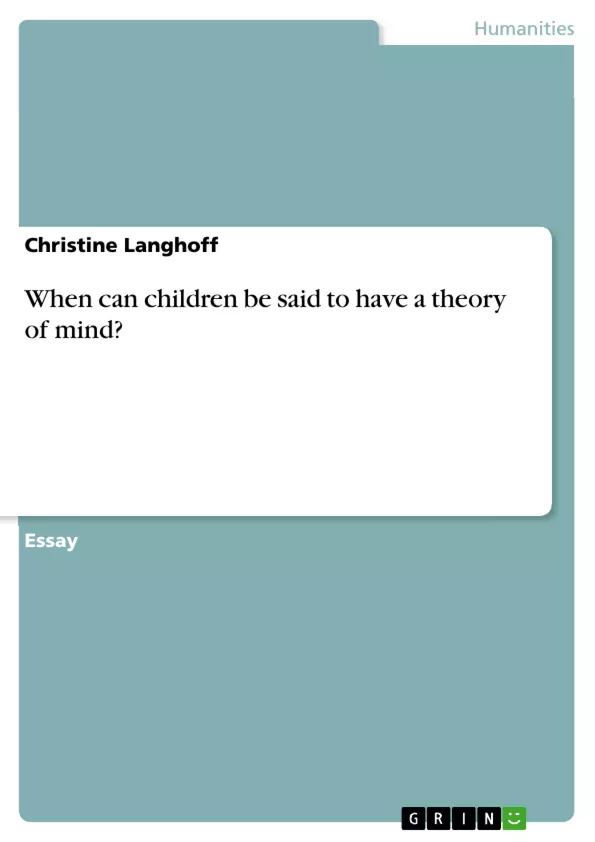Theory of mind has been defined as the ability to think about other people’s mental states and form theories of how they think. It is part of the so-called social cognition which is the term given to knowledge about people and affairs. The notion of theory of mind became important in Psychology following an experiment by Premack and Woodruff (1978) in which they attempted to test whether chimpanzees have a theory of mind. After the publication of this paper it was suggested that children could be tested to see if they had a theory of mind by giving them a false belief task. This is a test to see whether a child will act on a knowingly incorrect belief, or be aware that a second person who is not in possession of a certain piece of information may act incorrectly. Over the last decades many experiments with false belief tasks were conducted in order to test when children develop theory of mind and the results have shown that after about four years of age children realise that another person can have inaccurate belief about the world. However, it has been argued by some researchers that children develop theory of mind earlier and others have stressed that theory of mind cannot be regarded as fully developed in four-year-old children, but rather as a skill that develops for several years after children are successful on typical false belief tasks. I am going to explore some of the studies and arguments dealing with the question of when children can be said to have a theory of mind.
Inhaltsverzeichnis (Table of Contents)
- When can children be said to have a theory of mind?
- False Belief Tasks
- Wimmer and Perner (1983)
- Unexpected Transfer Task
- Deceptive Box Task
- Individual Differences in False Belief Understanding
- Language Ability
- Family Background
- Other Explanations for Failure on False Belief Tasks
- Executive Function
- Representational Skills
- Beyond False Beliefs
- Second Order Beliefs
- Development of Theory of Mind Beyond False Beliefs
- Theory of Mind and Emotion
- Deception and Theory of Mind
- Conclusion
Zielsetzung und Themenschwerpunkte (Objectives and Key Themes)
The text aims to explore the question of when children can be said to have developed a theory of mind. It examines the role of false belief tasks in assessing this development, considers individual differences in understanding false beliefs, and discusses other factors that may influence a child's ability to grasp the concept of mental states. The text explores the relationship between theory of mind and emotional understanding and investigates how children develop an awareness of deception.
- The development of theory of mind in children
- The use of false belief tasks to assess theory of mind
- Factors influencing individual differences in theory of mind development
- The relationship between theory of mind and emotional understanding
- The role of deception in understanding mental states
Zusammenfassung der Kapitel (Chapter Summaries)
- The text begins by defining theory of mind and outlining its importance in psychology. It discusses the use of false belief tasks, particularly the unexpected transfer and deceptive box tasks, to assess children's understanding of mental states. The text highlights the finding that most children succeed on these tasks around the age of four.
- Individual differences in performance on false belief tasks are explored, emphasizing the role of language ability and family background. It discusses the impact of siblings on theory of mind development and the importance of parental education.
- The text examines alternative explanations for failure on false belief tasks, considering factors such as executive function and representational skills. It presents evidence suggesting that young children might have general difficulties with representation rather than specific problems with mental state processing.
- The text moves beyond first-order beliefs and explores children's understanding of second-order beliefs, demonstrating that they are not fully developed until around the age of six. It discusses the ongoing development of theory of mind even after children succeed on typical false belief tasks.
- The text examines the relationship between theory of mind and emotional understanding. It presents evidence suggesting that children may take longer to grasp the connection between false beliefs and emotions than between false beliefs and behavior.
- The text explores the connection between deception and theory of mind. It discusses the capacity of young children to deceive and examines the argument that while children can produce misleading behavior, they may not always understand the impact of their actions.
Schlüsselwörter (Keywords)
The key concepts and terms discussed in the text include theory of mind, false belief tasks, unexpected transfer task, deceptive box task, language ability, family background, executive function, representational skills, second-order beliefs, emotional understanding, and deception.
- Quote paper
- BA (Oxon), Dip Psych (Open) Christine Langhoff (Author), 2004, When can children be said to have a theory of mind?, Munich, GRIN Verlag, https://www.grin.com/document/80247



